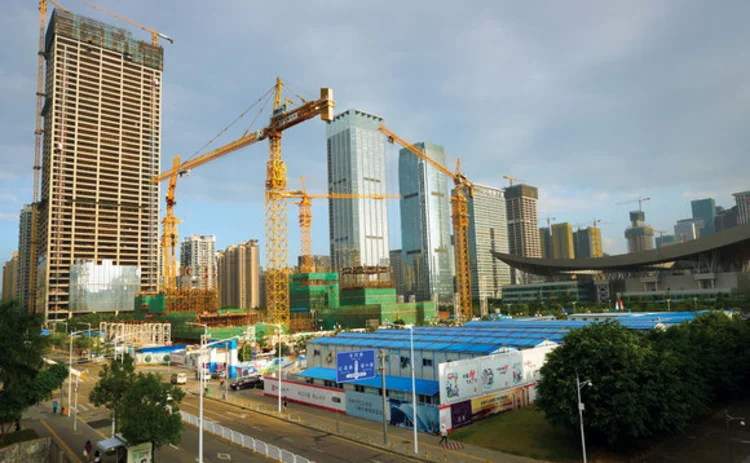
'Learning by doing' has transformed Chinese growth
Taxation structure is one of the reasons for the income inequality

China's first two decades of growth (1980-2000) were marked by the transformation from an agriculture-based economy to one dominated by the industrial and service sectors, and by rapid growth associated with poverty reduction. Learning through an experimental approach played an important role in the rapid productivity growth without the severe disruption that happened in the eastern European transition economies that adopted ‘shock therapy'.
Innovative approaches - such as the township and village enterprises, special economic zones (SEZs) and dual-price system - made it possible for rural migrants to participate in the rapid expansion of the industrial and service sectors and the process of urbanisation. Through ‘learning by doing' via openness to trade and FDI, China was able to explore its comparative advantages in low-cost labour, achieving economies of scale, and improving efficiency and productivity. The inclusive pattern of growth in the 1980s and 1990s was instrumental in expanding employment opportunities for the majority of the Chinese population and lifting over 500 million people out of extreme poverty.
Between 2000 and 2010, however, China's economic growth was driven largely by an over-reliance on exports, excessive capital accumulation and growth in energy-intensive industries, such as automobile, steel and cement production. This growth pattern was associated with structural imbalances and unprecedented growth in fixed-asset investment, while domestic consumption failed to keep up with the pace of GDP growth. The national income distribution skewed towards enterprises in the form of profits and to the government in the form of tax income, while the share of household income in the national economy eroded to an exceedingly low level by international standards. The sectoral imbalances were more striking, with a dominant industrial sector and a significantly underdeveloped service sector, compared with countries of similar income levels.
Despite progress in poverty reduction, inequality in China has risen sharply since the beginning of the 1978 economic reform. This rising trend of income inequality is confirmed using various measures and data sources. The Gini index increased sharply from the mid-1980s until 1985, when rural income growth started to slow down as a result of the shifting focus of development policies to the urban industrial sector and coastal regions. Compared with other large developing economies and Organisation for Economic Co -operation and Development (OECD) countries, China experienced the largest increase in inequality between the 1990s and 2000s.
The overall inequality in China was manifested in the regional disparity and rural-urban divide. The coastal-to-inland GDP per-capita ratio rose from 1.7 in the late 1980s to 2.4 in 2004,6 reaching the highest level in a half-century. In 2004, urban inequality accounted for about 36% of overall inequality, rising from 20% in 1989. Evidence based on targeted surveys showed that the average income of migrant workers was much lower than that of urban residents. And income inequality among migrants was much higher, with the Gini coefficient of hourly income at 0.42 for migrants, compared with 0.38 for their urban counterparts.7 This suggests that urban inequality is likely to be much higher when taking into account migrant populations.
Sources of rising income inequality
As China deepened its economic and structural transformation,rising income inequality was inevitable. A more important question concerns what is driving the country's rapidly increasing income inequality.
First, the geographic income disparity in China, particularly between the coastal and inland regions, is a top contributor to the overall inequality. The coastal provinces enjoyed geographic advantages because of their proximity to seaports and the closer links with newly industrialised economies such as Hong Kong, Singapore, South Korea and Taiwan. In addition, the labour force in coastal regions has a relatively better level of education.
Second, the government's preferential industrial policies also contributed to the income disparity between coastal and inland regions. In 1989, as the first step of its large-scale open-door policies, the government introduced SEZs, aimed at opening up coastal regions to international trade and attracting foreign direct investment (FDI). The openness to international trade and massive inflow of FDI no doubt played an important role in raising incomes in coastal regions at a much faster rate than in the rest of China.
Third, the significant increase in return to education is another major factor underlying rising inequality in China. The increasing dominance of the private sector in China's overall economy, together with the restructuring of stateowned enterprises (SOEs), intensifies competition among firms. To maintain competitiveness, firms strive to continuously improve efficiency, upgrade production through new investment and compete for more educated and skilled workers.
Fourth, a taxation structure that did not focus on redistribution of income has contributed to income inequality. Since 1995, China has started to modernise its tax system. However, China's taxation structure is quite different from those in developed economies, where income redistribution is more prominent than extraction of tax revenues from GDP production. Currently, the government derives its tax revenue mainly from indirect taxes (such as value- added tax and other consumption taxes), which account for about 57% of total tax revenue. Direct tax receipts, in the form of income and property tax, are much lower, amounting to about only 10% of total revenue in 2013. In addition, China taxed agriculture (a regressive tax) for over a thousand years - until 2006, when agriculture taxes were finally abolished.
In comparison, the tax structure in OECD countries relies heavily on income and property tax as the sources of revenue. In 2009, income and property tax accounted for about 69% of tax revenue, while indirect tax amounted to 31%, according to OECD data sources.
China's tax structure and collection system are still developing, with many loopholes for tax evasion and limited capacity for redistribution. Reform to property tax and inheritance tax, which are both redistributive, is being discussed but any changes are still far from implementation. Despite China's progressive income tax rate reaching 45% for monthly income over 80,000 yuan (about $12,900), in many respects, the current tax structure is regressive. This is because poor households bear a disproportionately larger burden of consumption tax, which dominates the total tax revenue, while the smaller share of income and property tax in total tax revenue limits its redistributive role. This conclusion is supported by the findings of Lopez, Thomas and Wang (2008).8 Moreover, for low-income employees, companies have to pay as much as 40% of their wage bill to meet contributions to social security and social welfare, including housing, unemployment, pension and medical benefits.
In addition to the problems in the tax structure, China also needs to improve its fiscal sharing system between central and local governments. The central government currently shares 75% of the value-added taxes, while most local government expenditure is done through budgetary and extra-budgetary revenues from land-related sales and taxes. The mismatch between fiscal income and fiscal responsibility is serious and has affected normal governmental functions in many poor regions. The highly centralised revenue management and decentralised service provision has resulted in a heavy reliance on local financing through bank borrowing and land sales.
The central government has realised the problems with China's fiscal system and has initiated a series of reforms, including transforming the business tax (a type of sales tax for service sector companies) into value-added taxes, legislation of local budget laws for more transparency and accountability, streamlining pension and social security coverage and financing, preparation of property and inheritance tax by establishing central property registration system, experimentation of local government bonds, etc. It should be pointed out that both government efforts and market forces are pushing China towards a more inclusive growth model.
The spatial difference in income is driving the flow of migrant workers from low-income regions to high-income cities. The preferential policies are quickly copied across regions as soon as their positive contribution to growth is confirmed. The one-child policy has also created an unusually high level of attention on families and on investment in education.
The advance of digital technology and big data may provide an opportunity for China to speed up its tax system reform so it can achieve lower tax rates and a fairer tax structure.
7 Lewei Zhang (2011), Income Inequality in Urban China: A Comparative Analysis between Urban Residents and Rural-Urban Migrants, working paper, Sanford School of Public Policy, Duke University.
8 Thomas, V, RE López and Yan Wang (2008), Fiscal Policies for the Quality of Growth, IEG Briefing 9, World Bank.
Only users who have a paid subscription or are part of a corporate subscription are able to print or copy content.
To access these options, along with all other subscription benefits, please contact info@centralbanking.com or view our subscription options here: subscriptions.centralbanking.com/subscribe
You are currently unable to print this content. Please contact info@centralbanking.com to find out more.
You are currently unable to copy this content. Please contact info@centralbanking.com to find out more.
Copyright Infopro Digital Limited. All rights reserved.
As outlined in our terms and conditions, https://www.infopro-digital.com/terms-and-conditions/subscriptions/ (point 2.4), printing is limited to a single copy.
If you would like to purchase additional rights please email info@centralbanking.com test test test
Copyright Infopro Digital Limited. All rights reserved.
You may share this content using our article tools. As outlined in our terms and conditions, https://www.infopro-digital.com/terms-and-conditions/subscriptions/ (clause 2.4), an Authorised User may only make one copy of the materials for their own personal use. You must also comply with the restrictions in clause 2.5.
If you would like to purchase additional rights please email info@centralbanking.com test test test


